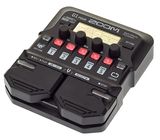Build quality: Except for the bottom of the unit, which is made of metal, the Zoom G1 Four is made entirely of plastic. However, the plastic seems sturdy and unlikely to break. Judging by how it looks and feels to the touch, I would say that it is probably polycarbonate, which is one of the most durable thermoplastics. Surprisingly, the footswitches do not feel flimsy at all and are not as easy to press as I had expected, which gives off an impression of quality. To sum up, considering the low price of the unit, it is built very well.
Handling: The Zoom G1 Four can be used in either the Memory Mode, which allows the user to switch between different patches, each consisting of up to five amplifier and speaker cabinet emulations and effects (this mode works similarly to the MIDI switchers), and it can also be used in the Stomp Mode, which allows to separately switch on and off any one of up to five emulations and/or effects. Each emulation and effect has its own icon, designed to look like the thing being emulated. I have heard some people complain that they make the user interface look unprofessional, but to me, those “childish”, as they say, icons are much quicker and easier to identify from a distance than the more mature looking black squares and hexagons used by Boss and Line 6. Also, to someone who was born in the early '90s, the icons and the pixelated screen remind me of Tamagotchis. In any case, I think, Zoom has the best UI by far. In fact, it is so intuitive, that I managed to figure it out without opening the manual once! I think, it says a lot. Also, the settings are highly customizable, but due to the way, in which the menus are structured, the amount of available options does not overwhelm a first-time user. However, what I love the most about the G1 Four is that it is completely self-sufficient: it not only has a built-in tuner, a headphone port, and an auxiliary jack (for playing backing tracks from your phone or laptop) but also dozens of rhythm patterns in various time signatures and a 30-second looper — all you need to practice, jam, or compose! To maximize convenience, I downloaded the free Zoom Guitar Lab software, which allows for an even easier patch editing on my laptop.
Sound quality: While the G1 Four might not be able to emulate a holy-grail vintage tube amplifier absolutely perfectly, to me, life is too short for “chasing phantoms” anyway. I used to own a Fender '65 Twin Reverb Reissue, and when I selected the corresponding setting on my Zoom G1 Four and turned up the spring reverb, the emulation was accurate enough to bring back from a distant memory the smell of my Fender's vinyl covering. When I closed my eyes, I could have sworn that it was standing right beside me with its tubes warmed up and glowing. To someone who mostly plays jazz, most of the default presets sound horrible, but the emulations and effects themselves are, as I have previously alluded, convincingly accurate. It simply takes some time and effort to dial them in just right, carefully adjusting the parameters to your individual style of playing and your instrument of choice.
Summary: To me, the Zoom G1 Four is a perfect practice tool. I have neighbors who watch TV at full volume, so I turn on some rain or ocean sounds on my phone, and plug it into the G1's auxiliary input. Then, when I put on my headphones, I can hear not only what I am playing but also the rain or the waves. I then lay back, close my eyes, and it feels as if I am jamming on a warm sunny beach somewhere in Hawaii...
Final note: Keep in mind that the G1 Four comes without the power supply (instead, four alkaline AA-sized batteries are included), so I would advise to order the Zoom AD-16 power adapter right away because it is more environmentally friendly and a lot more convenient.


